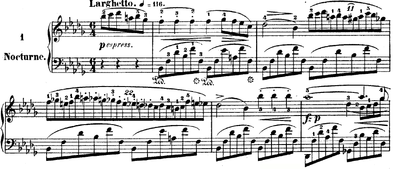Frederic Chopin’s Nocturnes opus 9 consist of three pieces that he completed from 1830 to 1832. Each piece has a distinct sound and form that helps to set them apart from each other. The works are dedicated to Madame Camille Pleyel and were published a year after they were completed in 1833. While the second Nocturne is by far Chopin’s most famous Nocturne, a discussion of the second one by itself would be incomplete without some mention of the other two Nocturne’s in the collection.
Nocturne in B-flat minor, Op. 9, No. 1
The first Nocturne consists of a series sextuplets that ascend and descend against a simple melody that moves in contrast to the rhythm of the bass. These melodies provide a juxtaposition of notes that complete with the triplets and create complex rhythmic ideas. The idea of placing rhythms in contrast to each other was a new concept that didn’t come into place until the Romantic Period in music. Listening to the first movement, the listener has a sense of a free, flowing and exciting adventure that requires a great deal of virtuosity on the part of the pianist. This Nocturne has a simple ABA form to it.
Nocturne in E-flat major, Op. 9, No. 2
The second Nocturne evokes imagery of melancholy isolation and longing. Written when he was only a 20-year-old, the piece has an evocative and romantic feel that expresses a great individualism and creative expression.

The piece uses a rounded binary form and that follows an AABABAC section format. The C section functions as a code to help round off and complete the piece. When played in conjunction with the first Nocturne, the second nocturne holds its place as a more elaborate and complex work. The melody has exciting and graceful leaps that help to accent chords and bring in a sensation of a truly free and complex melody. Again, as per Chopin’s style the third movement has many characteristics of both the first and third Nocturnes. In some ways, the second Nocturne acts a development section for the robust and exciting first Nocturne. The majority of the second Nocturne maintains a passive and somber feel until finally it bursts into an emotional and evocative section that sets the stage for the third Nocturne.
Nocturne in B major, Op. 9, No. 3
The final nocturne reminds the listener of the character of the first nocturne. In this way, it ties together the first and second Nocturnes in a sort of recapitulation. Until this time it is was rare for a composer to work out such an extended set of pieces that work together to form one cohesive whole. The form is a simple ternary form with an ABA form.